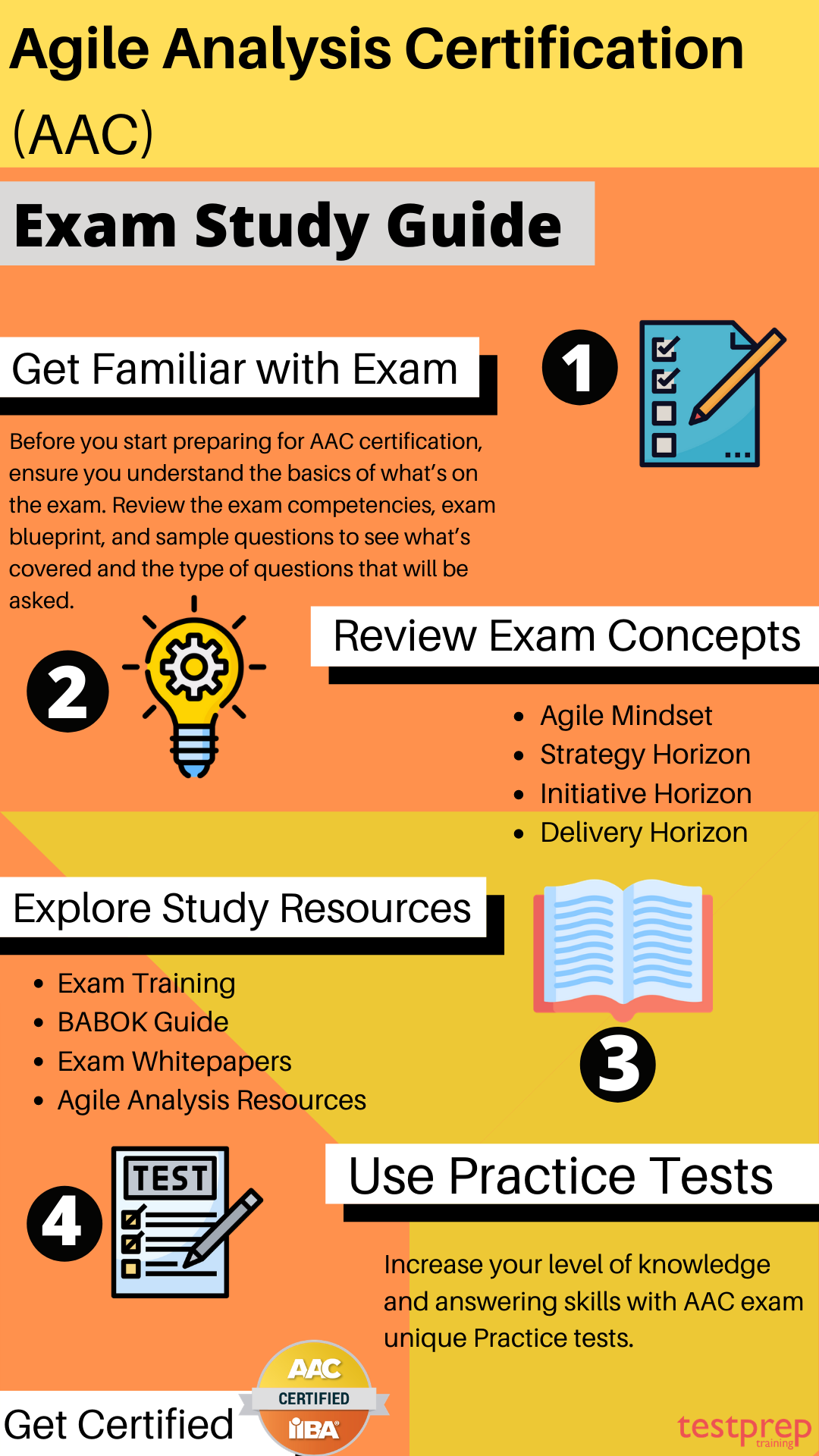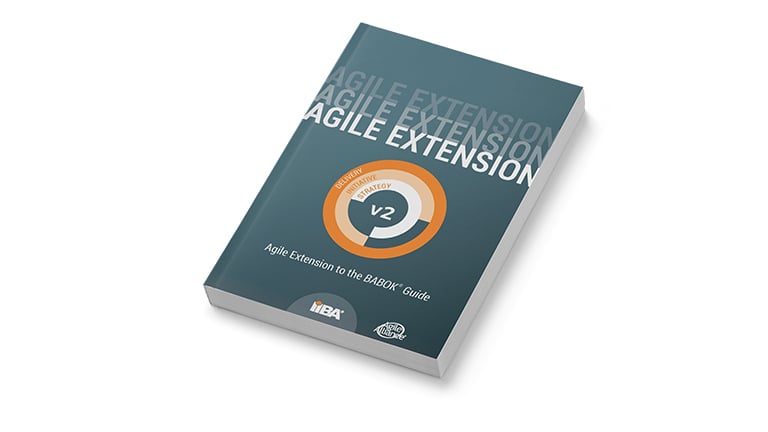Agile analysis is an approach to software development that emphasizes collaboration, flexibility, and responsiveness to change. The agile analysis involves breaking down requirements into small, manageable pieces, and continuously testing and delivering working software. The Agile Extension to the BABOK Guide, version 2 is associated with the IIBA Agile Analysis Certification (IIBA-AAC) exam. This exam assesses a candidate’s ability to respond to questions that are based on real-life circumstances.
The Agile Extension, which was created in partnership with the Agile Alliance, outlines good practices, procedures, and other critical information that improve business results and offer value to customers when work is completed utilizing multiple agile approaches. Candidates who do well on this test have demonstrated that they have acquired the necessary skills. The Study Guide provides you with the necessary materials and bridges the gap between you and your ideal career. This guide will undoubtedly pave the path for you to ace the exam and pass with flying colors.
IIBA AAC Certification Requirement:
The IIBA AAC test is a competency-based certification exam that assesses a candidate’s ability to gain new skills. This test, on the other hand, is for business analysts with two to three years of experience performing analysis and associated tasks in an agile environment.
Target Audience: Agile Analysis Certification
This certification is for:
- Firstly, candidates who are BA professionals and working in agile environments
- Then, those who have knowledge in increasing business analysis skillset and expertise
- Also, those who stay up-to-date on best practices and industry trends
Exam Learning Objectives
Candidates who pass the Agile Analysis Certification (AAC) Exam have demonstrated that they have acquired the necessary skills. The IIBA AAC test is based on a practice analysis study that identifies the analysis work agile leaders anticipate candidates to accomplish in an agile setting. This includes, for example,
 : Having a fundamental awareness of basic skills and knowledge involved in the work
: Having a fundamental awareness of basic skills and knowledge involved in the work
 : Recognizing the key elements of the work and why they are important.
: Recognizing the key elements of the work and why they are important.
 : Adhering to prescribed ways to complete the work but needs rules and guidelines to successfully execute.
: Adhering to prescribed ways to complete the work but needs rules and guidelines to successfully execute.
Study Guide for IIBA Agile Analysis Certification (IIBA-AAC)
The only thing that will get you closer to your goal is preparation. To pass the exam, you’ll need to put in a lot of effort and commitment, as well as a strong willpower. Because you are entirely committed to studying for the exam, your materials must be completely appropriate and accurate in order for you to pass. There are literally thousands of resources from which to pick. The only thing you should have in excess of what is required is a strong sense of drive and willpower. If you pick the appropriate set of materials, you will undoubtedly pass the exam.

1. Visit the Official Site
Make sure to go to the exam’s official website to get all of the information you need regarding the examination. The list of materials may be found on the IIBA Agile Analysis Certification exam’s official website. You can take one of their online courses or one of their other recommended ways. In order to pass the exam, you must also devote adequate time to each domain. The following domains are covered by the IIBA AAC exam:
Domain 1: An Agile Mindset
Firstly, this domain includes Agile Analysis basics, and Agile Philosophy. Subsequently, Agile Analysis principles and Introduction to Horizons.
Domain 2: Strategy horizon
This domain covers the concepts to develop Initial Product Backlog / Required Business Capabilities and identify Capabilities. Also, release planning and Scope MVP/MMF. In addition, Ongoing strategy work, Stand-up (weekly/monthly) and Identify Scenarios. Also, Review and Maintain Product Backlog / Required Business Capabilities and Identify new items
Domain 3: Initiative Horizon
This domain includes topics to Develop Initial Release Log / MVP Backlog, Identify features and identify solution options. Also, identify solution components, Release planning Scope MVP/MMF & subsequent product increments. Then, Estimate features, prioritize features and elaborate features. In addition, Review / Update solutions components, Release close , review outcomes produced including: “Are we continuing to deliver value?” and update scope for next Release / MVP
Domain 4: Delivery Horizon
This domain covers the concepts to Develop Initial Release Log / MVP Backlog . Also, Identifying features, and solution options. Furthermore, Identify solution components, release planning and scope MVP/MMF & subsequent product increments. Then, Estimate features, Prioritize features and Elaborate features. In addition, Review / Update solutions components, Release close, Review outcomes produced including: “are we continuing to deliver value?” and Update scope for next Release / MVP
2. Familiarize yourself with Agile principles and practices
Before diving into the details of Agile analysis, it’s important to understand the underlying principles and practices of Agile. Read the Agile Manifesto and Agile Principles, and explore different Agile methodologies such as Scrum, Kanban, and Lean.
3. Learn about the Agile analysis process
Agile analysis involves a set of practices for gathering, analyzing, and managing requirements in an Agile environment. Study the Agile analysis process and the key artifacts involved, such as user stories, product backlogs, and sprint backlogs.
4. Understand the role of the Agile analyst
The Agile analyst is responsible for ensuring that the team has a clear understanding of the requirements and that the delivered software meets the needs of the stakeholders. Learn about the key responsibilities of the Agile analyst, such as facilitating requirements workshops, writing user stories, and collaborating with the development team.
5. Study Agile analysis techniques
There are several techniques used in Agile analysis, such as story mapping, prototyping, and acceptance testing. Learn about these techniques and how they can be used to gather and validate requirements in an Agile environment.
6. Explore Study Resources
Your preparations will be led by Learning Resources. These are essential components of your preparation for the test. Let’s review the IIBA AAC test utilizing the suggested resources.
– Exam Training Course
From entry into the field to retirement, IIBA provides training providers around the world with courses that support the ongoing professional development of business analysis (BA) professionals. All IIBA training, however, offers applicants with internationally recognised best-practice standards, such as the BABOK Guide and the Agile Extension for development, in order to help them obtain the IIBA Agile Analysis Certification (IIBA-AAC). This training will help in:
- Firstly, Supporting your growth in the BA field
- Secondly, Preparing you for taking an IIBA certification exam
- Thirdly, Enabling the maintenance of your IIBA certification
– BABOK Guide
BABOK guide helps applicants to learn the associated skills and information that are underlying competencies to make you great at your work. On the other hand, this provides six knowledge areas for the IIBA Agile Analysis Certification (IIBA-AAC):

- Firstly, Business Analysis Planning and Monitoring: This describes the tasks for organizing and coordinating business analysis efforts.
- Secondly, Elicitation and Collaboration: This explains the tasks used for preparing and conducting elicitation activities and confirming the results.
- Thirdly, Requirements Life Cycle Management: This explains the tasks for managing and maintaining requirements with designing information from inception to retirement.
- Also, Strategy Analysis: This includes the tasks to identify the business need and then addressing that need with aligning the change strategy within the enterprise.
- Subsequently, Requirements Analysis and Design Definition: This defines the tasks to organize requirements, specify and model requirements and designs, validate and verify information, and estimate the potential value that could be realized.
- Further, Evaluating Solution: This explains the tasks for assessing the performance and value delivered by a solution for recommending improvements on increasing values.
– Whitepapers
IIBA offers whitepapers that are published and curated by IIBA’s Global Thought Leadership program in collaboration with industry influencers and partner organizations. However, the whitepapers provide guidance and best practices information for addressing digital transformation and new technologies to deliver better business outcomes.
– Agile Analysis Resources
IIBA works with global experts and practitioners across different markets to examines trends and shifting markets in business analysis to enable organizations to deliver better business outcomes. The agile analysis comes with:
- Agile Process Design
- Embrace Agility whitepaper
7. Using the Practice Tests
This is a crucial component that will assist you in better preparing for the exam. That is to say, practice exams are important as they allow you to examine yourself and determine your weak and strong areas. However, by taking IIBA AAC sample exam tests, you may enhance your response abilities and save a significant amount of time. Furthermore, the optimum time to begin practicing exams is after you have completed one whole topic, since this will serve as a revision tool for you. As a result, be sure to look for the best practice resources. Let’s Start using IIBA AAC Practice Exam Tests NOW!
Benefits of Agile Analysis Certification
There are several benefits to obtaining an Agile Analysis Certification. Here are some of the key advantages:
- Demonstrates expertise: Obtaining an Agile Analysis Certification demonstrates that you have a deep understanding of Agile principles and practices, as well as the skills needed to effectively gather and analyze requirements in an Agile environment.
- Improves career prospects: Having an Agile Analysis Certification can improve your career prospects by making you more marketable to potential employers. Many companies are now looking for professionals who are certified in Agile analysis.
- Enhances credibility: Certification adds credibility to your professional profile and shows that you are committed to ongoing learning and development in your field.
- Boosts team productivity: Agile analysis can help teams become more productive and efficient by breaking down requirements into small, manageable pieces and continuously testing and delivering working software. As a certified Agile analyst, you can help teams adopt these practices and achieve better results.
- Increases salary potential: Certified Agile analysts typically earn higher salaries than their non-certified counterparts, due to their specialized knowledge and skills.
Conclusion
Agile analysis is a key component of Agile software development and plays an important role in ensuring that software is delivered on time, on budget, and to the satisfaction of stakeholders. Becoming certified in Agile analysis demonstrates your knowledge and skills in this area, and can help you stand out in a competitive job market.
To prepare for the certification exam, it’s important to understand Agile principles and practices, the Agile analysis process, and the key responsibilities of an Agile analyst. It’s also helpful to practice with sample questions and attend training courses.
Finally, staying up-to-date with industry trends is critical to your success as an Agile analyst. Attend conferences, read industry blogs, and join online communities to stay informed about the latest developments in Agile analysis.
By following these tips and committing to ongoing learning and development, you can achieve success as an Agile analyst and make a valuable contribution to your organization.



